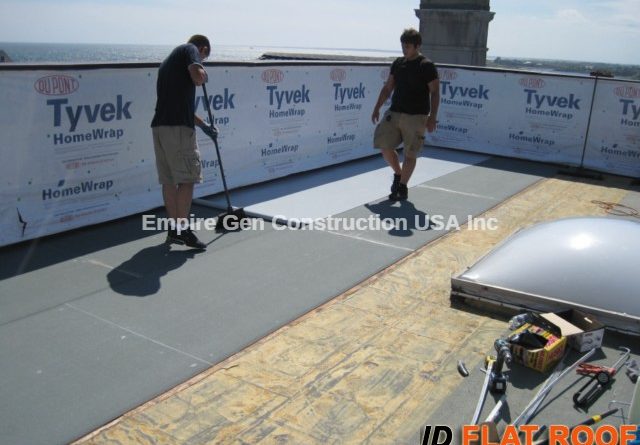Where should You begin when my flat roof starts leaking?
Repairs and renovations are inevitable because no roof is ever going to last forever. Weather and water may easily destroy flat roofs. The roof can become inundated with water due to a malfunctioning drainage system or periods of excessive rainfall. Roof damage occurs when water seeps into the insulation. You need to take immediate action by contacting Flat Roof Contractors NY NY if water is seeping into your flat roof.
Get ready for these subjects!
- Why is my flat roof leaking?
- Recognizing a leaking flat roof
- Repairing a flat roof that has leaked
Why is my flat roof leaking?
A flat roof eventually wears out due to weather factors, particularly strong temperature swings and significant rainfall. One of the most common reasons for flat roof leaks is standing water. Roof deterioration and mold growth result from water seeping into the structure. A flat roof that is leaking could be the result of simple mistakes in design or poor repair work.
Quickly looking at the most prevalent reasons why flat roofs leak:
- Problems with planning and building
- Neglecting upkeep
- Mistakes made during refurbishment or repair
- Sealing issue
Roof types dictate the materials used for waterproofing and thermal insulation. The majority of flat roofs are sealed using bitumen or plastic membranes. They have a 20- to 30-year lifespan. Performing routine maintenance by Roof Repair NYC on a flat roof allows you to spot potential problems and weak spots before they become major issues.
Greenery on a flat roof or a flat roof terrace increases the likelihood of leaks, particularly in the seams and along the edges of the roof. This is not type-specific, thus it can have the same effect on hot, cold, or inverted roofs.
Combination of roofing materials
A flat roof is constructed by Residential Roofing Contractors NY NY bringing together different materials at corners and seams. For your flat roof to last as long as possible, these are the most important considerations. There is strain and tension at the connecting sites because the materials utilized expand at various rates when heated. Here, we pay special attention to chimneys and drains.
You should so, during your routine visual inspection, pay close attention to the points of connection of the following materials:
Bitumen to sheet metal: A bonded connection is preferable since bitumen expands more than sheet metal.
Pavers, stone, and plaster with concrete: It is common practice to inject a silicone connection here since concrete expands more readily than stone or plaster.
It is common practice to use a plastic-based adhesive to attach plastic to concrete because plastic is softer than concrete.
The process of joining plastic and sheet metal involves the use of an adhesive derived from plastic, similar to that used with concrete.
Finding a flat roof that is leaking
Standing water: Roof drains and drainage are common places for mistakes to happen while building a flat roof. When it rains, the water lands on them, thus even little holes can swiftly become huge problems. Hence, watch out for pools of stagnant water. Either the roof drains are clogged or there is a flaw in the design.
Indoor mold development and water stains: Water stains, discoloration, damp areas, or mold development in the interior spaces are signs of leaks on flat roofs. Once you notice this damage, it’s time to figure out what caused it.
Exorbitant energy bills: Energy bills will reflect a lack of roof insulation in the middle of the road. The roof should be considered by Local Law 11 contractor NY as a potential source of quickly increasing energy usage. Leaks on flat roofs can often go undetected until substantial damage has already taken place to the roof structure or the underside of the roof, depending on the thickness of the insulation.

